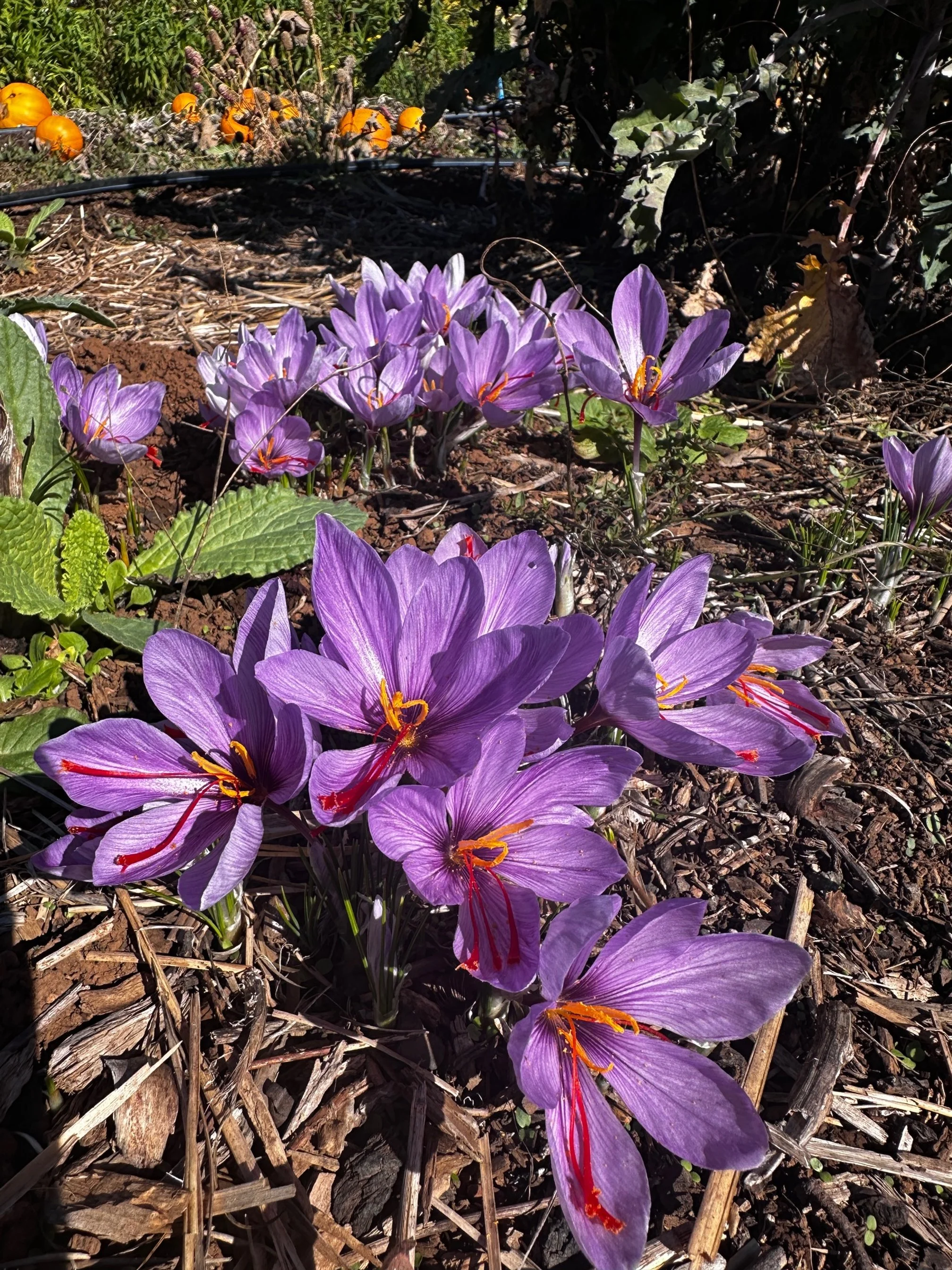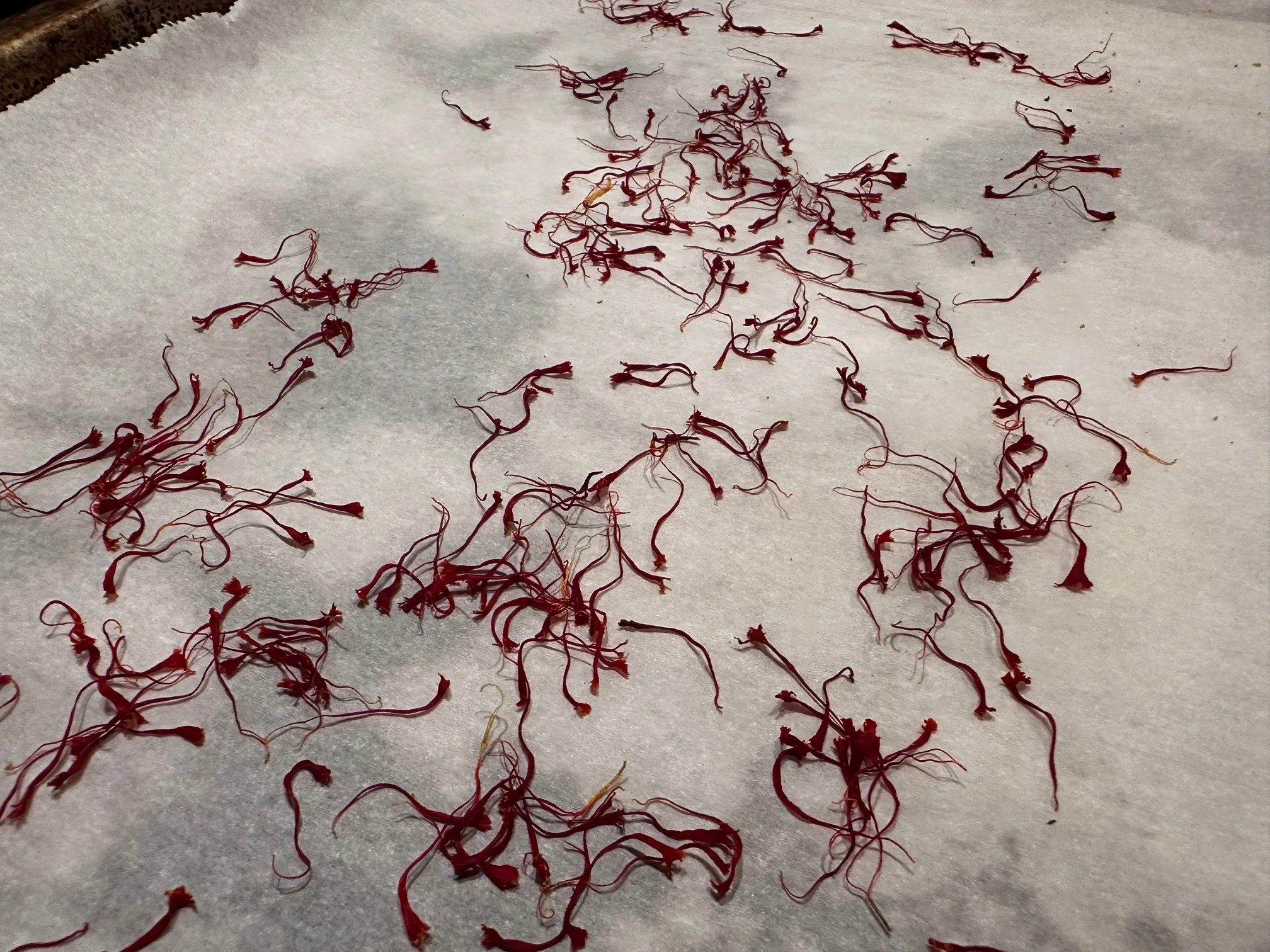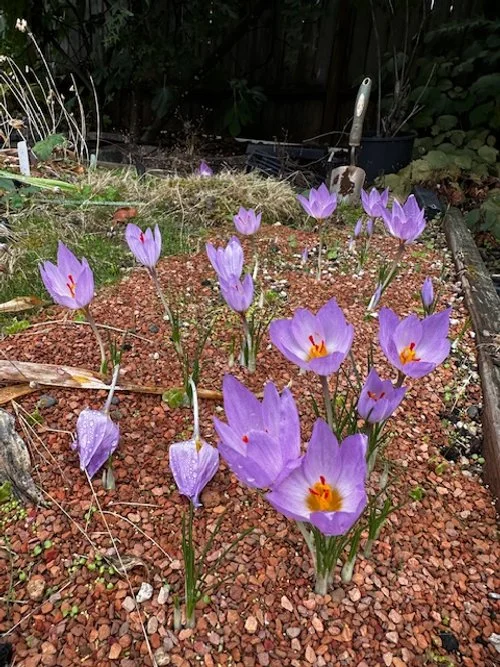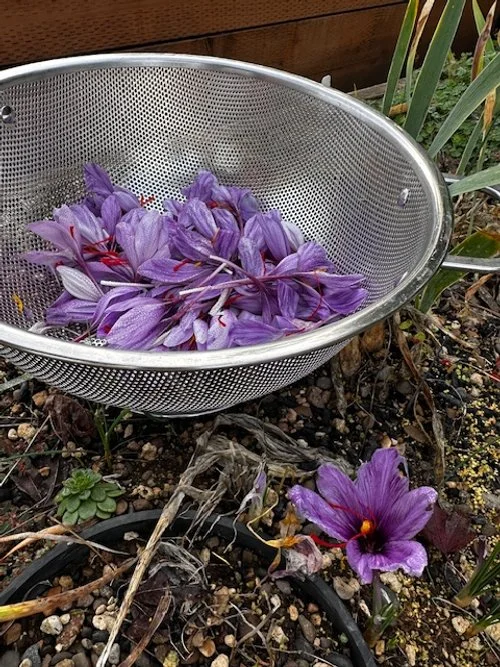Saffron and the Silk Road
The year is 850 ce, A young Kyrgyz horseman sits astride his shaggy mountain pony on the ridge above the Alay Valley. The beast’s breath steaming in the cold night air as the frost line settles into the lower valleys from the Pamir Mountains in the distance. Below him, the saffron caravan enroute to Samarkand and the lucrative Abbasid trade markets had kindled its fires by the willow-lined stream, the orange glow flickering over the hulks of hobbled camels and the silhouettes of weary guards hunched at their pots of tea. The grass around him was brittle with frost, feathergrass bending in the wind, releasing the sharp scent of crushed wormwood and thyme beneath his ponies unshodden hooves. He shifted uneasily in the saddle, pulling his felt cloak tighter, his eyes fixed on the waxed tarpaulin bundles near the fire where the saffron—worth more than gold—lay unburdened from the camels. Behind him, the other raiders whispered low in Turkic, their ponies stamping softly against the stony soil. The stars burned hard and clear in the thin air, and though he had ridden these high steppes all his life, the boy felt his stomach twist with fear and anticipation. Just before dawn, when the guards’ heads nodded in the chill, they would descend like wolves.
The leader of this group of bandits bent down and and dug for something amidst the bunch grasses, chewing a root of the blue flowered Gentian might help settle his stomach a bit. He knows this raid could be has last, he had been carefully surveying the caravan for a week now, staying stealthily hidden off the main road, picking a way through the mountain passes via small goat trails to intersect the caravan every few days. He had watched carefully the behaviors of the hired Turkic mercenaries who guarded the camel convey. They carried the curved steppe sabres of fine steel made in the foundries in Burkhara and were amply supplied with armor of hardened leather. The leader of the caravan carried a shorter straight bladed sword that he could tell was made of Damascaus steel, his cuirass armor was of a finely woven felt, so tight that an arrow could only pierce it from close range. That sword would be a fine enough prize, but the saffron in the bundles could settle his outlaw ways for life. He mused on the thought of spending the wealth in the bathhouses and brothels of Kashgar (modern day Xinjiang, western China) where he would ironically sell the saffron back to the same merchants that sold it to the Samarkand traders. He would live like a king if only he would live through the coming dawns raid.
The smell of roasting lamb on the convoys fire drifted up the into the raiders lookout, and his stomach panged, he chewed a bit harder on the gentian root and tried not to think about the smells of the well appointed encampment below as his group had eaten only a few bites of kazy, the sun dried horsemeat that was a staple for them and a bit of the qurut, the dried salted cheese from mares milk over the last week as they stalked the convoy. One by one the stars began to disappear above the encampment as the sky lightened toward the east ever so much, the fires glow began to fade signaling to the raiders the guards were possibly nodding off to sleep. He got up and without a word, just hand signals and taps on the shoulder of his companions, the raiders quietly mounted the short legged ponies. His mount, a shaggy bay exhaled in long, visible puffs that steamed like smoke in the bitter night air. Each nostril flared with the effort of holding still, and the rhythm of the pony’s warm breath rose in gentle clouds, curling and fading into the sharp chill. The small mountain ponies of the kyrgyz would not match the high bred stallions of the caravan if it came down to a chase across the steppe, but the plan was to hit them swiftly with surprise and then retreat to the boulder strewn mountain trail. The familiarity with the terrain would be a great advantage. The short stocky kyrgyz horses could move swiftly though the boulder fields and across the scree slopes where the arabians faster but less sure footed steeds would falter. He took one last look around, spat the well chewed gentian root out into the bunch grass and strode the pony over his young companion overlooking the camp. “Yaqın bol, men bilen” he whispered, “Stay close to me.”
The group of bandits slowly picked there way down from the mountain, making sure to keep the dark of the mountain behind them and the lightening sky of the east ahead of them. In the willows by the creek, the now slumbering saffron caravan seemed unnervingly quiet.
The air seemed to hold its breath with them, the horses’ huffs steaming into the darkness, as they waited for the signal to descend. The lead riders nocked arrows to the mulberry, sinew and bone handled recurve bows, each assigned a guard or lookout to target in the oncoming slaughter.
“Bügün ölürüz, erte hakan kibi yaşay!”
The leader whispered to the group as they slowly began to fan out across the short distance of plain to the saffron carvan. “Today we die; or tomorrow, we live like kings!”
A murmur of assent rises from the other riders, their hoods and cloaks barely concealing grins and tension alike. The light breeze ruffles through the willows along the camp and as it fades up the stream, a camel grunts as it yawns and in the now waning darkness death awaits those and the prize for the alive is saffron.
Crocus sativus, the saffron crocus blooming at illahe this week as the pumpkins begin to take on the colors of Autumn.
I am lucky I never had to tread such perilous paths in search of this marvelous spice, I would see a tiny thimble sized glass vial in my moms spice cabinet as a kid. Later as a young man learning to cook, I would take pains at the cost of that tiny vial in the trader trader joes spice aisle. Now as an accomplished flower bulb grower and nursery man, one spice I do not want for in this world is saffron. Having grown it for many years now I have a plethora in the spice cabinet but unfortunately have been unable to turn such a lucrative crop into the riches of old such as would find me in a brothel or bathhouse living like a king.
My dad and brother were just on a similar route as the spice traders on the road to Samarkand described above, I couldn’t help but follow their journey along the ancient silk road with some wonder and awe as they made their way from China to Turkmenistan and onto Turkey. So when I promised a blog on the cultivation of saffron I couldn’t help myself to penning a little glimpse into what life must have been like for those that had to trade histories most valuable spice. Click on the gallery below for a photo guide to harvesting your saffron and read on for some tips on culture of this wonderful flower bulb!
I have written many times about the saffron group of crocus’ so you can journey back in time via the blog to find those writings which I won’t rehash too much of here. The story of saffron is ancient and some of it lost to time. It likely originated as a sterile triploid (unable to make seeds) in ancient persia around 3,000 years ago. No one knows for certain if it was a chance mutation or a man made hybrid that produced the first saffron. The first bulb of Crocus sativus to bloom with its 3 large protuding stigmas, that stain your fingers yellow and perfume your whole house or more likely yurt back in those days, it would have been a wonder to behold.
The young horseman’s eyes panned down at the fading flickering fires of the caravan, lingering on the sealed waxed bundles of saffron stacked near the camels. He knew enough of the traders’ world to understand its power: a few crimson threads could make a sick man well, lift a weary heart, or ease the pain of a woman in labor. In Samarkand, the merchants would pay handsomely for it, calling it more precious than silver or horses. He swallowed the dry lump in his throat, tugged his felt hood lower over his face, and felt the familiar stir of greed and hunger. Today it would be theirs—or nothing; the threads of saffron, the promise of health, wealth, and honor, all hung in the cold night air like the fading stars above.
If you are going to grow saffron here are a few things you should know, the corms are best planted deeply somewhere in the neighborhood of 6-8” deep. In Oregon anyway it thrives in my native jory clay loam soil, I don’t water it all during the summer dormancy. Not even a drop of water. It does need decent drainage and doesn’t want to sit in ponded water all winter, although I do find that it will take occasional flooding during the winter growing period. The first blooms will appear in late September or early October, although some years I have harvested well into December. The real challenge in our seasonally wet climate is the autumn rains will wreck the flowers, turning them into slimy sodden mess. The flowers are best harvested when they are open to the fall sunshine, which around these parts can be few and far between. I have meant for some years to erect a small row cover over the main saffron bed, which here at illahe is a raised bed about 12’ long by 4’ wide and raised 18” above the native grade of soil. Camas pocket gophers aka Camas rats which we have in abundance are a notorious pest and I am still waiting for the large bed to start producing after the garden and saffron beds were mobbed by these 4lb endemic gopher that loves the taste of flower bulbs and destroyed much of the cutting garden this year.
In the camp, the caravan master stirred from his bed roll by the rush of wind through the willows, he arose and buckled on his damascus blade. He walked through the camp as the thick smell of smoking firewood and camels permeated the air. He knelt beside the wax-sealed bundles of saffron, fingers brushing over them as if considering not just their weight but the months of labor and sweat pressed into every crimson thread. His eyes swept the circle of guards, and there—half-hidden by the flicker of firelight—one of them slumped forward, head nodding as sleep claimed him despite the bitter cold. A sharp frown creased the master’s weathered face. “This is more than spice,” he muttered under his breath, “a few threads can lift a sick man’s spirits, ease a woman’s pain, calm a fever and cure plagues—but no magic will guard it if vigilance fails.” He knew the peril facing them on the long road ahead, he had suspected they were being followed as any caravan duly loaded would be. If raiders were to come was not the question, it was when they could they would come. He leaned closer, inhaling the sharp mix of fire and camels and the odor of unwashed bodies with the dust and grit of the steppe mixed with the days sweat and whispered a warning into the guards ear.
Once your saffron is producing nicely, you pluck the flowers on that sunny autumn day that finds them open and the stigmas long and protuding. I pick the whole flower and do batches at time, as the work of saffron harvesting is equal in measure to it’s value in currency. Down on bended knees for the flowers only reach 6” or so above the soil level can be a task your back will remind you of later in life. Gathering the flowers into a basket, I then sit at a table to remove the stigmas which I do by hand, often looking jaundiced after in the finger tips. The gallery above shows the freshly picked stigmas laid out on a sheet of parchment paper on a cookie sheet. Drying is tricky and I’m sure some scientific method of exacting standards is laid out somewhere in google land. I do what I can with what I have and here is my method: open the oven so that the door is set ajar by several inches, the temp is raised to the lowest setting possible which on my oven is 170' deg F. the stigmas spread on the parchment lined cookie sheet to not touch each other as much as possible are occasionally shifted through shaking the sheet and the whole process usually takes less than 20 minutes until they are dry to the touch and almost crispy. I then pack them in glass jars and seal them tightly. The fragrance does change over time and I must say I like the old stuff as much as the new stuff as it darkens and oxidizes it almost seems to bring out a richer deeper flavor than the freshly dried material. I have harvested saffron from the much smaller stigma’s of Crocus thomasii, and the flavor is different but with it’s sweeter, honey like perfume it does make an amazing saffron rice or paella as well.
The guard stirred at the words of the caravan leader and wrestled himself to an upright position, the embarrassement of dereliction showing on his face as struggled to gain composure. Now at nearing the edge of the willow lined stream the Kyrgyz horsemen could see the faint stirrings in the camp, the younger of the two wincing a bit with the feeling that the ambush was not going as planned and that the saffron caravan would soon be stirred to action. The older and wiser leader of the group had been watching the interaction between the caravans master and the guard and knew the time to strike was now. The Kyrgyz leader leaned low over his shaggy bay, eyes glinting in the starlight, and lifted a single hand. A tense hush fell across the flat plain at the edge of the willows as every horseman froze, nostrils flaring, muscles coiled. Then his voice cut the cold air: “Ok at!” In an instant, a storm of arrows leapt from the darkness, whistling through the night toward the flickering fires of the caravan. Camels brayed and stumbled, the stallions tied by the waters edge reared and whinied at the sudden breach of early morning calm. Sparks of fear lit the master’s face as the realization that the time had come. He barked orders, but the arrows came too fast, too many, striking the tarps, the packs, and the ground around him. The snoozing guard was caught with an arrow that plunged through his chest all the way to the goose feather fletching and he spun faced down at the edge of the fire, grasping at the arrow protruding out his back and spluttering frothy pink blood as it had pierced his lungs. The night exploded in chaos, and the raiders surged down into the camp like shadows, ponies surging, hooves clattering against the frost-hardened grass, intent on seizing the bundles filled with the crimson threads of saffron before a single caravan hand could mount a defense.
The history of saffron is long and filled with stories imagined like the one above or real tales of loss, from the bloody transactions of the ancient silk road to the collapse of American saffron farming due to the war of 1812. The historic uses as an aphrodisiac, a cure for medieval plagues, dyes, carmanitive, mood enhancer and even to modern day research into it’s anti cancer properties make it one of the most fascinating and fun to grow bulbs. If you were lucky enough to pick up some at this past weekends HPSO Plant fest sale, I hope this little blub enhances your understanding of the value and culture of this unique and beautiful bulb and it’s spicy stigmas.
P.S. Plant orders are being shipped out Monday-Wednesday so we don’t have boxes sitting in warehouses over the weekend, we should have all remaining orders out early next week so check your inbox for tracking numbers so you can expect arrival. I will do a final inventory of the fall season and post the shop back up hopefully by this weekend. This final offering of the fall season will include a few leftover bulbs at a discount and even a few bareroot offerings for those that area ready to plant.
Cheers,
Mark










